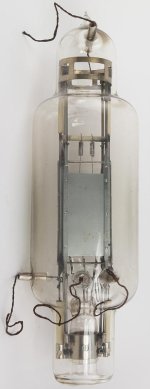As I understand it, tubes and transistors do the same job, tubes are just more complicated. I understand why one might call a tube a "valve", but then isn't the term equally applicable to a transistor? Yet I see valve used to uniquely describe a vacuum tube. Is it just history and tradition?
In some parts of the world they were never normally referred to as tubes.
Bipolar transistors are more complicated than a tube, using quantum mechanics and all that.
Tubes are ballistic devices.
The earliest experimental vacuum tubes were literally built inside glass tubes, hence the name.
"Valve" is just a colloquialism the English use, like "torch" for flashlight.
In power electronics, more recently, we term transistors as "switches".
Tubes are ballistic devices.
The earliest experimental vacuum tubes were literally built inside glass tubes, hence the name.
"Valve" is just a colloquialism the English use, like "torch" for flashlight.
In power electronics, more recently, we term transistors as "switches".
Last edited:
tubes are just more complicated.
I would say the physics behind the thermionic valve is easier to understand than the physics behind the transistor.
Rayma just beat me to it!
Is it just history and tradition?
Just history, as the thermionic valve came first.
The first vacuum tube, made by English physicist John Ambrose Fleming in 1904, only allowed charge to flow in one direction and not in the opposite direction - hence its likening to a water valve.
Tubes --> like a waterfall
bipolar transistor --> Ψnkr = e^ikr x unk(r)
(and more, that's just the start).
You decide.
bipolar transistor --> Ψnkr = e^ikr x unk(r)
(and more, that's just the start).
You decide.
Last edited:
The first vacuum tube, made by English physicist John Ambrose Fleming in 1904, only allowed charge to flow in one direction and not in the opposite direction - hence its likening to a water valve.
Actually a water valve is bidirectional, it's the water pressure that is polarized.
There are "check valves" however, that do allow only one direction of flow.
bipolar transistor --> Ψnkr = e^ikr x unk(r)
The worst part is, I can’t tell if that’s gibberish or real math 😅
"The worst part is, I can’t tell if that’s gibberish or real math."
Quantum potential in a crystal lattice.
At the frontier, the distinction fades. Some math proofs are now hundreds of pages long.
Even the researcher's office mate may not be able to make sense of their paper.
Quantum potential in a crystal lattice.
At the frontier, the distinction fades. Some math proofs are now hundreds of pages long.
Even the researcher's office mate may not be able to make sense of their paper.
Last edited:
There are "check valves" however, that do allow only one direction of flow.
As in the Tesla valve.
I used to repair electronic gear for navigation and communication that had "vacuum tubes" or just "tubes'. Never saw any electronic valves. Or no "vacuum valves". I guess it was not a thing in North America.In some parts of the world they were never normally referred to as tubes.
Ok, you guys are right about physics! I was thinking of the multiple voltage requirements and such for running a tube vs the simple three pins of a transistor.
The physics of the tube are rather classical electro-magnetism.
The physics of the a transistor take into account atomic physics.... and don't forget that 0.6V drop.
Besides, it's more fun to work with a 440V power supply than 36V!
The worst part is, I can’t tell if that’s gibberish or real math 😅
it should be obvious
(1) The left term should be a function of (r)
(2) The right term uses (r) correctly only half way and he used 'unk(r)' which in reality should be zap(r)
Try this:
https://www.electronics-tutorials.ws/diode/diode_2.html
In the UK, the term "tube" colloquially referred to the cathode ray tube or picture tube of a TV set.
The term "valve" was reserved for those pesky little doodahs that the TV service man seemed to delight in replacing!
The term "valve" was reserved for those pesky little doodahs that the TV service man seemed to delight in replacing!
The term 'tube' has a certain 'informality', commonly seen in North American naming conventions but generally avoided in some other places.I guess it was not a thing in North America.
The picture tube which Galu refers to could be seen a little differently since the shape has a connection to the function.
We called them tubes here, because they were standard off the shelf glass tubes, adapted for the purpose.
The name was literal, not informal, since there was no other name for them at the time (or even now).
A 1920 De Forest transmitting tube.
The name was literal, not informal, since there was no other name for them at the time (or even now).
A 1920 De Forest transmitting tube.
Attachments
Last edited:
- Home
- Design & Build
- Parts
- Why are tubes called "valves" but transistors aren't?
